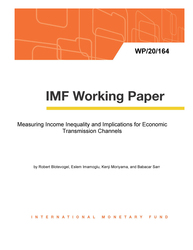
Measuring Income Inequality and Implications for Economic Transmission Channels
Measuring Income Inequality and Implications for Economic Transmission Channels
READ MORE...
Volume/Issue:
Volume 2020
Issue 164
Publication date: August 2020
ISBN: 9781513554501
$18.00
Add to Cart by clicking price of the language and format you'd like to purchase
Available Languages and Formats
| English |
Prices in red indicate formats that are not yet available but are forthcoming.
Topics covered in this book
This title contains information about the following subjects.
Click on a subject if you would like to see other titles with the same subjects.
Labor , Economics- Macroeconomics , WP , inequality indicator , event study , income share , capital consumption , price level , income inequality , share indicator , series amount , Income inequality , Personal income , Income distribution , Human capital , Disposable income , Global , economic growth , fragile countries , growth transmission channels , inequality measurement , and political stability , share series
Summary
We study the channels that theoretically transmit the effects of inequality to economic growth, unlike much of the existing literature that focuses on the direct linkage. The role of inequality in these transmission channels is difficult to pin down and varies with the particular inequality indicator chosen. We run our analyses with six methodologically distinct inequality measures (Gini coefficients and Top10 income shares). Methodological differences within the set of Gini coefficients and the Top10 income shares exert a first-order impact on the estimated relationships, which is generally larger than the effect of switching between Gini and Top10 income shares. For a given inequality indicator, we find that the transmission channels can react in opposite directions, with the net effect on growth difficult to determine. Finally, we emphasize two additional but so far underappreciated empirical complications: (i) estimated relationships change over time; and (ii) fragile countries create significant but counterintuitive empirical associations that may obscure structural relationships.
Copyright © 2010 - 2025
Powered by:
AIDC



